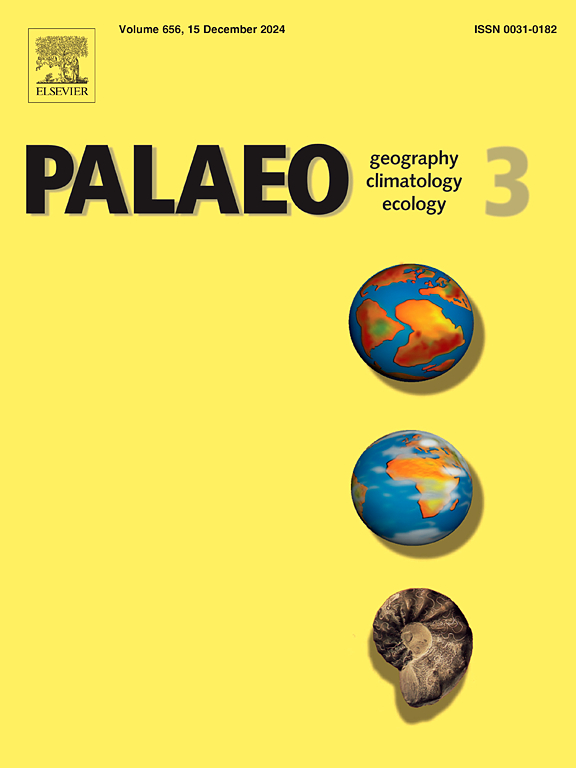伊比利亚半岛最近两万年的气候变化,以小型哺乳动物群为特征
IF 2.6
2区 地球科学
Q2 GEOGRAPHY, PHYSICAL
Palaeogeography, Palaeoclimatology, Palaeoecology
Pub Date : 2024-10-11
DOI:10.1016/j.palaeo.2024.112545
引用次数: 0
摘要
在整个地球历史上,气候和环境都发生了重大变化,这些变化都反映在动物记录中。从这个意义上说,小型哺乳动物与其相关环境的密切关系为我们提供了宝贵的古生态学见解。我们的研究调查了从晚更新世到全新世伊比利亚半岛小型哺乳动物群落的动态,比较了地区环境变化和人类活动的影响。我们对伊比利亚半岛 26 个考古遗址中的小型哺乳动物群落进行了研究,结果显示,北部和南部地区的小型哺乳动物群落有着不同的反应。晚更新世的寒冷气候条件有利于中欧物种(例如,Alexandromys (Oecomicrotus) oeconomus、Chionomys (Chionomys) nivalis)在北部地区的存在,直到全新世中期,而其他类群如今仅限于伊比利亚北部(例如,Arvicola amphibius)、Arvicola amphibius、Microtus gr. (Euarvicola) arvalis、Sorex araneus-coronatus)在末次冰川极盛时期到达了南部地区,但在全新世初期就消失了。古环境重建表明,晚更新世主要是开阔的地貌和寒冷的气候,全新世早中期,北部地区的森林覆盖率增加。相比之下,南部地区的环境比北部地区更加稳定。我们的研究结果强调了环境的多样性以及自然和人为因素之间的相互作用如何影响了过去两万年间伊比利亚小型哺乳动物群落的组成。最具体地说,在全新世晚期,小型哺乳动物的生物地理格局主要受到人类活动的影响,一些物种(Microtus (Iberomys) cabrerae)的分布发生了变化,一些新的物种(同类物种)进入了这一时期。本文章由计算机程序翻译,如有差异,请以英文原文为准。
The last 20,000 years of climate change in the Iberian Peninsula characterized by the small-mammal assemblages
Climate and environments have undergone significant changes throughout the Earth's history, which are reflected in the faunal record. In that sense, small mammals provide valuable palaeoecological insights due to their close relationship with their associated environments. Our research investigates the dynamics of small mammal communities in the Iberian Peninsula from the Late Pleistocene to the Holocene, comparing regional environmental variations as well as anthropogenic impacts. Our review of the small mammal assemblages from 26 archaeological sites across the Iberian Peninsula revealed a differential response of the small mammal communities between the northern and southern areas. The colder climatic conditions which characterized the Late Pleistocene favoured the presence of mid-European species (e.g., Alexandromys (Oecomicrotus) oeconomus, Chionomys (Chionomys) nivalis) in northern regions until the Mid Holocene, while other taxa today restricted to northern Iberia (e.g., Arvicola amphibius, Microtus gr. (Euarvicola) arvalis, Sorex araneus-coronatus) reached southern regions during the Last Glacial Maximum but disappeared at the beginning of the Holocene period. Palaeoenvironmental reconstructions indicate predominantly open landscapes and colder climates in the Late Pleistocene, with increased forest cover during the Early-Mid Holocene in northern areas. In contrast, the southern regions exhibited more stable environments compared to the northern ones. Our results underscore how the great environmental diversity and interactions between natural and anthropogenic factors affected the composition of Iberian small mammal communities during the last 20,000 years. Most specifically, during the Late Holocene, biogeographical patterns of the small mammals are mostly affected by anthropic activities, with changes in the distribution of some species (Microtus (Iberomys) cabrerae), and the entrance of new ones (synanthropic species).
求助全文
通过发布文献求助,成功后即可免费获取论文全文。
去求助
来源期刊
CiteScore
5.90
自引率
10.00%
发文量
398
审稿时长
3.8 months
期刊介绍:
Palaeogeography, Palaeoclimatology, Palaeoecology is an international medium for the publication of high quality and multidisciplinary, original studies and comprehensive reviews in the field of palaeo-environmental geology. The journal aims at bringing together data with global implications from research in the many different disciplines involved in palaeo-environmental investigations.
By cutting across the boundaries of established sciences, it provides an interdisciplinary forum where issues of general interest can be discussed.

 求助内容:
求助内容: 应助结果提醒方式:
应助结果提醒方式:


